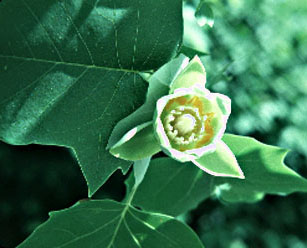

The tulip tree, Liriodendron tulipifera,
is native to our eastern United States. This species is one of only two
in the genus Liriodendron, which is one of many genera within the
magnificent magnolia family. The other species, Liriodendron chinense,
or Chinese tulip tree, is a smaller-flowered native of China that is rarely
planted as an ornamental. The leaf bases of the tulip tree allow the leaves
to quiver in the breeze much as aspen or poplar leaves; thus, L. tulipifera
was also given the erroneous common name of yellow poplar. Unfortunately,
this common name has stuck in spite of many efforts to correct this inappropriate
nomenclature. Its common name, tulip tree, comes from its flowers, which
are said to be tulip-shaped and have a colored band at their base, much
like many tulip flowers do. The flowers are large greenish yellow cups with
a basal orange band and are  produced
at the tips of the branches. Unlike Magnolia flowers, which often
appear before the foliage, Liriodendron flowers bloom after the foliage
has emerged and may be overlooked as they can be very high up in larger
trees.
produced
at the tips of the branches. Unlike Magnolia flowers, which often
appear before the foliage, Liriodendron flowers bloom after the foliage
has emerged and may be overlooked as they can be very high up in larger
trees.
Flowers and fruits are first produced when tulip trees are 15-20 years old. They may be evident only when the spindle-shaped cones of overlapping winged seeds become visible in the fallafter foliage has dropped. Keep a close eye out in the next month or so at the trees in the islands next to the heating plant, in front of Buildings and Properties, and the fleet garage for these interesting flowers. L. tulipifera flowers produce lots of nectar for the bees that pollinate them, and tulip tree honey is sold as a commercial product. Unfortunately, the bees are not very efficient pollinators in this species, so that pollination success is not very great. A great many seeds do not develop and remain empty. Luckily, those seeds that mature can remain alive in the leaf litter for many years until sites are disturbed by fire or other activity, which results in emergence of thick stands of seedlings. This survival strategy allows tulip tree to be a very effective pioneer species on disturbed sites.
Tulip tree leaves have an alternate arrangment on the stem, like their Magnolia cousins, although tulip tree leaves are saddle-shaped and 24-lobed. The bright yellow autumn foliage of these trees is an interesting contrast to the maple red and oranges and oak bronzes. Another interesting feature that makes tulip tree different from other deciduous trees is its winter buds, which are flattened and rounded up at the tips, resembling ducks' bills.
One of the most distinctive North American trees, Liriodendron tulipifera has value as both a timber and wildlife species. It is a large tree with a tall, clear, arrow-straight trunk and an open crown of stout, nearly erect branches, and grey, deeply fissured bark. Tea made from the bark was used in the past as a quinine substitute in the treatment of malaria and typhoid. Tulip tree is tied with sweetgum for attaining the greatest height (200 ft) of any eastern deciduous tree and may be the most massive as well, reaching a diameter at breast height (dbh) of 12 feet! L. tulipifera is long-lived, fast growing and has a deep wide-spreading root system. It thrives in deep, well-drained, moist, rich soils, such as lowlands and bottom lands along rivers. This state tree of Indiana, Kentucky and Tennessee may be a choice for your home landscape, and is a beautiful ornamental where a large tree is called for, but only if you give it plenty of room to grow!
by Cathy Heidenreich
Next (Magnolias: Part III)
Return to Arboretum Home Page
Return to NYS Agricultural Experiment Station Home Page